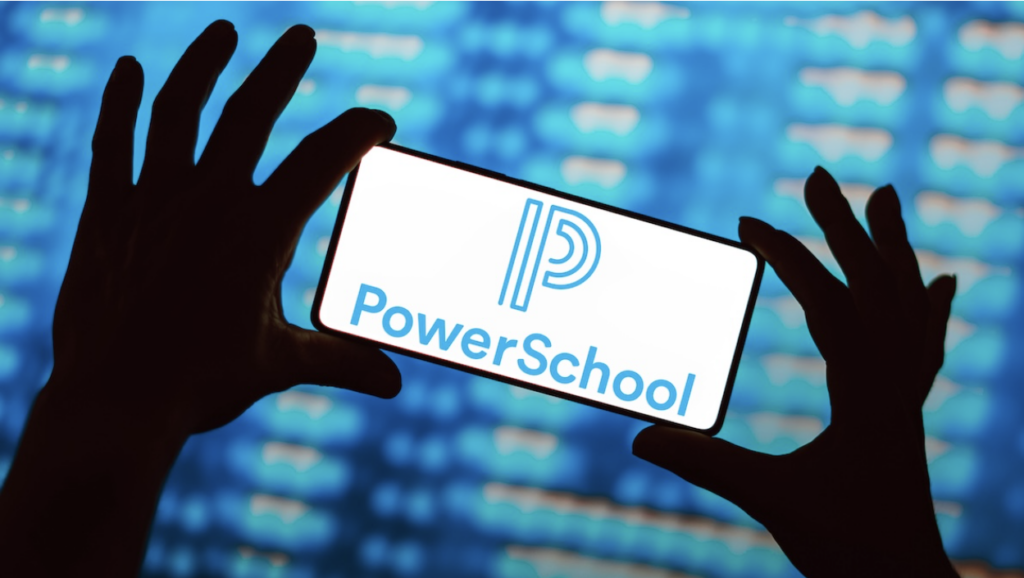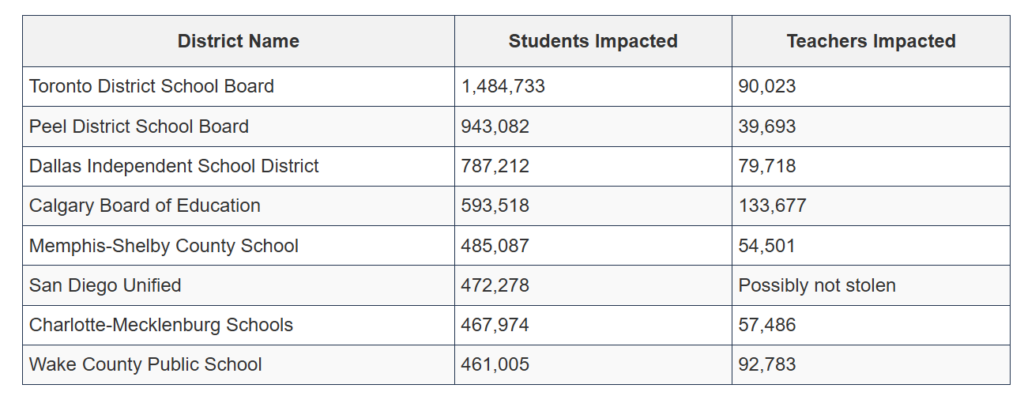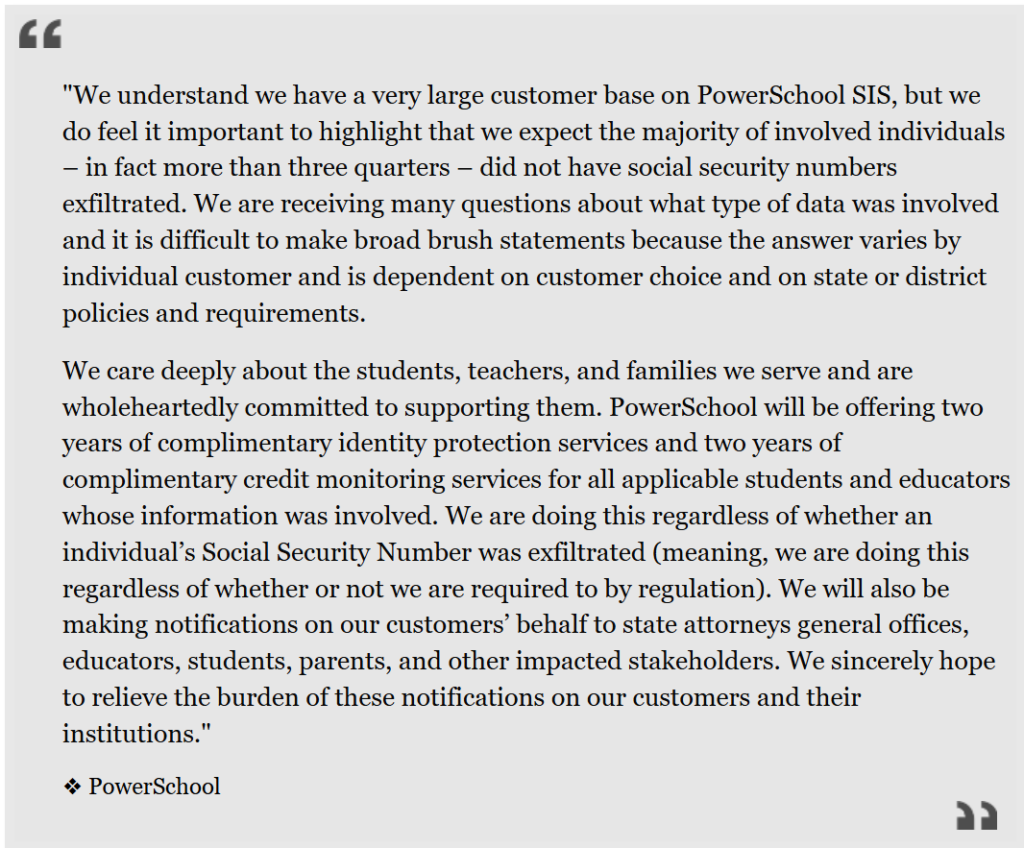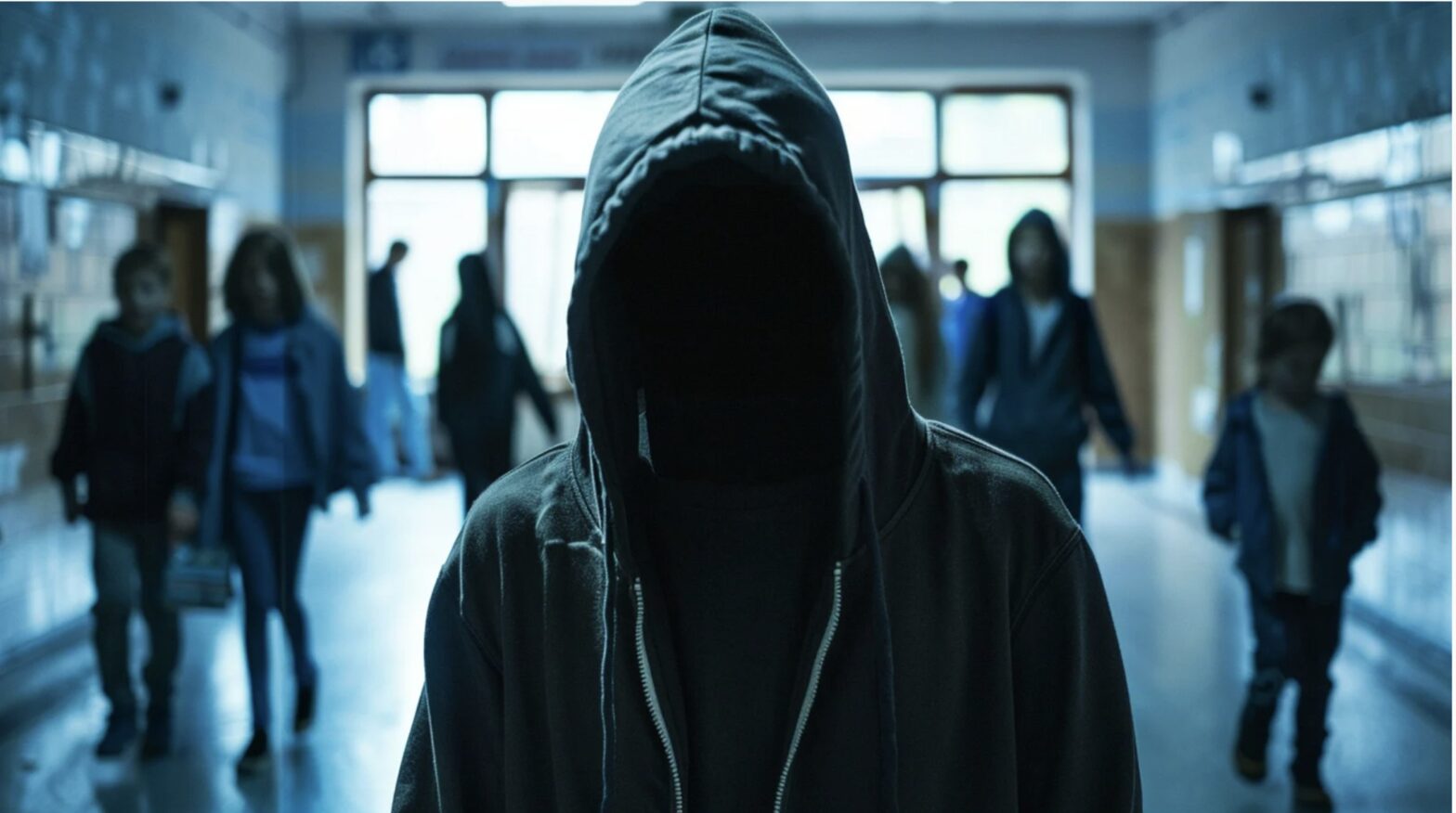In a shocking revelation, education technology giant PowerSchool has confirmed a massive cyberattack that compromised sensitive information belonging to millions of students and teachers. This breach is a wake-up call for educational institutions worldwide, underscoring the urgent need for enhanced digital security.

The Scale of the Breach
The scope of the PowerSchool breach is staggering. On January 7th, the company disclosed that cybercriminals used stolen credentials to infiltrate their Power Source customer support portal. Exploiting this access, the attackers leveraged a maintenance tool to download data from districts’ PowerSIS databases. The result? The personal information of 62.4 million students and 9.5 million teachers was exposed across 6,505 school districts in the U.S., Canada, and beyond.
Here are some of the most heavily impacted districts:

Notably, Canadian school boards often encompass entire regions, leading to larger numbers compared to individual U.S. districts.
What Was Stolen?
PowerSchool has confirmed that a variety of sensitive data was stolen, including Social Security Numbers, medical information, and grades for some students. However, they estimate that less than a quarter of affected individuals had their Social Security Numbers exposed. The data compromised varies widely by district, reflecting differences in local policies regarding information storage.
PowerSchool’s Response
Faced with an unprecedented breach, PowerSchool has rolled out several initiatives to mitigate the impact:

- Free Protection Services: All impacted students and educators will receive two years of free identity protection and credit monitoring services—a step taken regardless of whether Social Security Numbers were part of the stolen data.
- Streamlined Notifications: To ease the burden on schools, PowerSchool is handling breach notifications to state attorneys general, educators, students, and parents on behalf of affected districts.
- Forensic Investigation: Cybersecurity firm CrowdStrike is leading an in-depth investigation. While an incident report was initially promised by January 17th, it has been delayed, leaving customers with a confidential fact sheet summarizing key findings so far.
- Public Transparency: PowerSchool has launched a dedicated website where stakeholders can monitor updates on the breach and its aftermath.
Unresolved Concerns and Transparency Gaps
While PowerSchool’s transparency through private FAQs is commendable, parents, educators, and administrators remain frustrated by the lack of detailed information. The delayed release of the full incident report has only heightened concerns, leaving many to wonder about the true scale and implications of the breach.
Key Takeaways for Educational Institutions
This breach isn’t just a crisis for PowerSchool—it’s a cautionary tale for the entire education sector. As schools and districts increasingly rely on digital tools, robust cybersecurity measures must become a top priority. Safeguarding sensitive data is no longer optional; it’s essential to maintain trust and protect the communities these tools serve.
PowerSchool now faces the challenge of regaining the confidence of millions of educators, students, and families. Their ongoing response, coupled with future improvements in security, will determine whether they can rebuild the trust that has been so deeply shaken.
The Need for Cybersecurity in Education
For those affected by this breach, vigilance is key. Monitoring financial accounts and taking advantage of the free identity protection services offered by PowerSchool is a critical first step. Meanwhile, the education sector as a whole must prioritize investments in secure infrastructure to ensure that students and teachers can focus on learning without fear of future breaches.
References:
https://fox2now.com/news/national/over-60m-kids-data-may-have-been-stolen-what-you-need-to-know/
https://www.securityweek.com/millions-impacted-by-powerschool-data-breach
https://www.k12dive.com/news/powerschool-data-breach-lawsuits-negligence/737900


This is such an important and timely post! Kamaldeep
The sheer scale of this breach is shocking, and it’s definitely a wake-up call for the education sector to take cybersecurity more seriously. I’ve come across a lot of articles about this recently, and the consistent theme is the same—schools and tech providers need to prioritize protecting sensitive data. PowerSchool’s response is a step in the right direction, especially with the free identity protection services, but the delayed report and lack of full transparency leave many questions unanswered. This situation really underscores how critical it is for educational institutions to adopt stronger security practices to safeguard the trust of students, parents, and teachers. Thanks for shedding light on this—it’s a conversation we all need to have!
Interesting post Kamaldeep!
I believe the way data is stored at rest is as important as when data is in use or in transit! Policies regarding information storage across districts should be standard as when breach like this happens, it mostly across systems and networks so Powerschool should look into how in depth their security is across networks and systems irrespective of district, and ensure they have a robust cyber security plan and incident management and response plan as well. I hope every organization can learn one or two from this incident!
I think you did well highlighting the gravity of the PowerSchool breach and its far reaching implications for the education sector. Technology is deeply integrated into our schools now, and as a former teacher with one of the listed school districts, I only shake my head at this incident – it could have been prevented. So, while PowerSchool’s response – free identity protection, notifications, dedicated website, etc – is a step in the right direction, it doesn’t actually address the root of the problem: prevention. The fact that stolen credentials were enough to infiltrate such a significant platform raises concerns about their authentication protocols and overall security posture. Was MFA implemented and enforced? I don’t remember ever having to use it to login as a teacher. Why wasn’t such a basic security measure in place for a system handling millions of students’ and educators’ data? Were students trained on creating strong passwords? Based on my experience, students kept their initial password set to them by their teachers or librarians throughout their time at school, and never changed it. Further to this, the ability for attackers to exploit a maintenance tool to extract such a vast amount of data suggests insufficient network segmentation and monitoring.
The delayed response is another red flat – what happened to transparency? While confidentiality is sometimes necessary during investigations, the lack of clarity on how this breach occurred and what concrete steps are being taken to prevent future incidents undermines the confidence that PowerSchool is trying to restore.
As we demand better from tech providers, schools and districts much also step up by prioritizing cybersecurity training and enforcing stricter data governance policies. Otherwise, the education sector will remain a prime target for cybercriminals – and students, educators, and families, will continue to bear the brunt of these failures.
Also, what is the real cost of paying the ransom?
Nice post Kamaldeep! Students and teachers’ information are a valuable asset for schools and hackers. Medical records, SSN, grades and other sensitive information is something that we should keep safe. I couldn’t find further information on how the information was leaked, but it is clear that there were vulnerabilities on the PowerSchool platform. Only time will say if the confidence in this platform will be fully recovered. Thanks for the information!
Wow! The amount of data exposed in this breach is enormous and especially concerning. Schools house a large amount of PII, which begs the need for a strong cybersecurity program. However, it appears they have a decent breach response process as they provided free identity protection and credit monitoring for the victims, however, if the source or more details on the breach are not provided, this could lead to some level of reputational damage as this may be seen as an attempt to cover the true impact of the breach. The education sector is a particularly vulnerable sector and sometimes a target for these bad actors which means digital security measures must be prioritized just as teaching resources are.